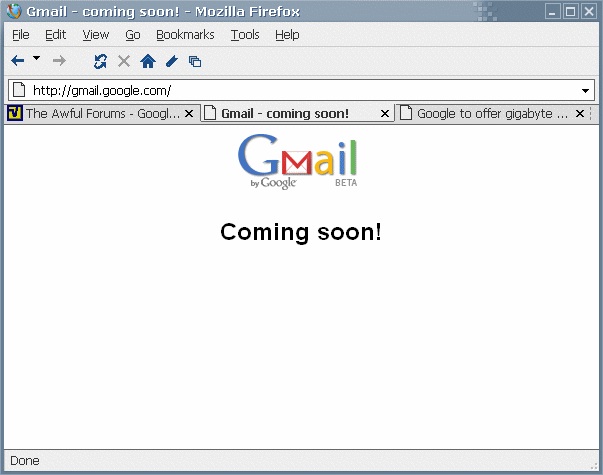
If you wanted to pick a single date to mark the beginning of the modern era of the web, you could do a lot worse than choosing Thursday, April 1, 2004, the day Gmail launched.
Scuttlebutt that Google was about to offer a free email service had leaked out the day before: Here’s John Markoff of the New York Times reporting on it at the time. But the idea of the search kingpin doing email was still startling, and the alleged storage capacity of 1GB—500 times what Microsoft’s Hotmail offered—seemed downright implausible. So when Google issued a press release date-stamped April 1, an awful lot of people briefly took it to be a really good hoax. (Including me.)
Gmail turned out to be real, and revolutionary. And a decade’s worth of perspective only makes it look more momentous.
The first true landmark service to emerge from Google since its search engine debuted in 1998, Gmail didn’t just blow away Hotmail and Yahoo Mail, the dominant free webmail services of the day. With its vast storage, zippy interface, instant search and other advanced features, it may have been the first major cloud-based app that was capable of replacing conventional PC software, not just complementing it.
Even the things about Gmail that ticked off some people presaged the web to come: Its scanning of messages to find keywords that could be used for advertising purposes kicked off a conversation about online privacy that continues on to this day.
Within Google, Gmail was also regarded as a huge, improbable deal. It was in the works for nearly three years before it reached consumers; during that time, skeptical Googlers ripped into the concept on multiple grounds, from the technical to the philosophical. It’s not hard to envision an alternate universe in which the effort fell apart along the way, or at least resulted in something a whole lot less interesting.
“It was a pretty big moment for the Internet,” says Georges Harik, who was responsible for most of Google’s new products when Gmail was hatched. (The company called such efforts “Googlettes” at the time.) “Taking something that hadn’t been worked on for years but was central, and fixing it.”
It All Began With Search
Gmail is often given as a shining example of the fruits of Google’s 20 percent time, its legendary policy of allowing engineers to divvy off part of their work hours for personal projects. Paul Buchheit, Gmail’s creator, disabused me of this notion. From the very beginning, “it was an official charge,” he says. “I was supposed to build an email thing.”
He began his work in August 2001. But the service was a sequel of sorts to a failed effort that dated from several years before he joined Google in 1999, becoming its 23rd employee.
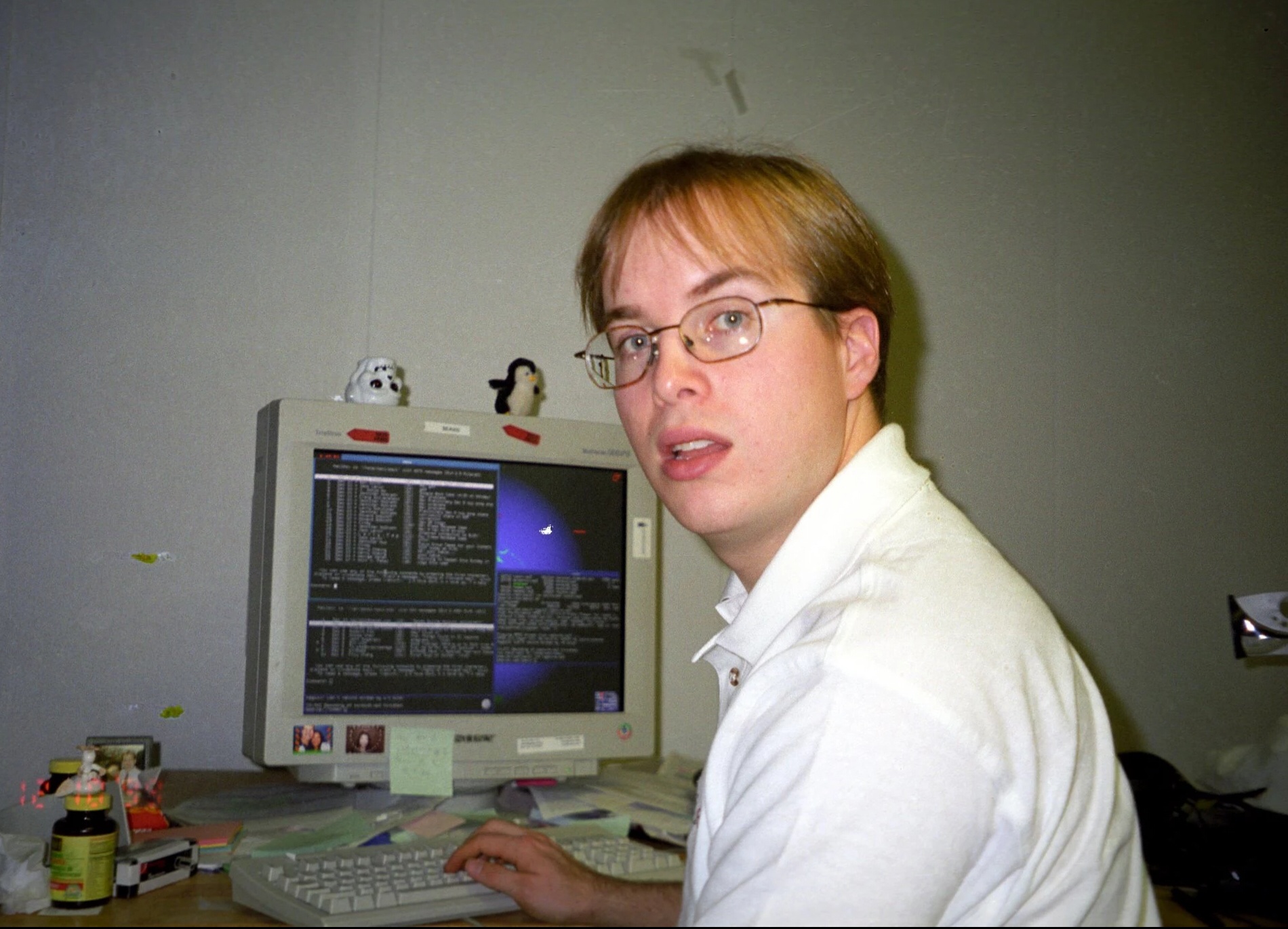
“I had started to make an email program before in, probably, 1996,” he explains. “I had this idea I wanted to build web-based email. I worked on it for a couple of weeks and then got bored. One of the lessons I learned from that was just in terms of my own psychology, that it was important that I always have a working product. The first thing I do on day one is build something useful, then just keep improving it.”
With Gmail–which was originally code-named Caribou, borrowing the name of a mysterious corporate project occasionally alluded to in Dilbert–the first useful thing Buchheit built was a search engine for his own email. And it did indeed take only a day to accomplish. His previous project had been Google Groups, which indexed the Internet’s venerable Usenet discussion groups: All he had to do was hack Groups’ lightning-fast search feature to point it at his mail rather than Usenet.
At first, Buchheit’s email search engine ran on a server at his own desk. When he sought feedback from other engineers, their main input was that it should search their mail, too. Soon, it did.
The fact that Gmail began with a search feature that was far better than anything offered by the major email services profoundly shaped its character. If it had merely matched Hotmail’s capacity, it wouldn’t have needed industrial-strength search. It’s tough, after all, to lose anything when all you’ve got is a couple of megabytes of space.
But serious search practically begged for serious storage: It opened up the possibility of keeping all of your email, forever, rather than deleting it frantically to stay under your limit. That led to the eventual decision to give each user 1GB of space, a figure Google settled on after considering capacities that were generous but not preposterous, such as 100MB.
"A lot of people thought it was a very bad idea, from both a product and a strategic standpoint."
Still, long before Google chose to give Gmail users 1GB of space, it had to decide that Gmail would be a commercial product at all. That wasn’t the no-brainer it might seem, even though Google had a maniacally email-centric culture itself.
In its early years, one of the defining things about the company was its obsessive focus on its search engine; that set it apart from Yahoo, Excite, Lycos and other search pioneers that had recast themselves as “portals,” expanding their ambitions to encompass everything from weather to sports to games to, yes, email. Portals had a reputation for doing many things, but not necessarily doing them all that well.
“A lot of people thought it was a very bad idea, from both a product and a strategic standpoint,” says Buchheit of his email project. “The concern was this didn’t have anything to do with web search. Some were also concerned that this would cause other companies such as Microsoft to kill us.”
Fortunately, the doubters didn’t include Google’s founders. “Larry [Page] and Sergey [Brin] were always supportive,” Buchheit says. “A lot of other people were much less supportive.”
Buchheit had been working on his project for a month or two when he was joined by another engineer, Sanjeev Singh, with whom he’d found social-networking startup FriendFeed after leaving Google in 2006. (FriendFeed was acquired by Facebook in 2009.) The Gmail team grew over time, but not exponentially; even when the service launched in 2004, only a dozen or so people were working on it.
Gmail’s first product manager, Brian Rakowski, learned about the service from his boss, Marissa Mayer, on his first day at Google in 2002, fresh out of college. (He’s still at Google today, where he currently works on Android.) What he saw got him excited, but it was still an exceptionally rough draft.
“It didn’t look anything like what Gmail does now or even what it looked like when it launched,” he says. “I was just graduated from school and was indoctrinated in usability tests and target users. I was pretty paranoid that Google engineers would love it and it wouldn’t appeal to the mass market. I agonized over it a lot.”
All along, though, Gmail’s creators were building something to please themselves, figuring that their email problems would eventually be everybody’s problems. “Larry said normal users would look more like us in 10 years’ time,” Rakowski says.
What Does Google Email Look Like?
Even in August of 2003, two years into the effort, Gmail had only the most rudimentary of front ends. That’s when another new Google recruit, Kevin Fox, was assigned to design the service’s interface. (After leaving Google, he reuinited with Buchheit and Singh at FriendFeed.)
Fox knew that Gmail needed to look Googley; the challenge was that it wasn’t entirely clear what that meant. The company didn’t yet offer an array of services: Other than the company’s eponymous search engine, one of the few other precedents Fox could draw inspiration from was Google News, which had debuted in September of 2002. But search and News were both websites. Gmail was going to be a web app.
“It was a fundamentally different kind of product,” he says. “Fortunately, they gave me lots of latitude to explore different design directions.” Fox aimed for something that took cues from both websites and desktop applications without mindlessly mimicking either. After three major passes on the design, he settled on the look that’s still very much recognizable in today’s version of Gmail.
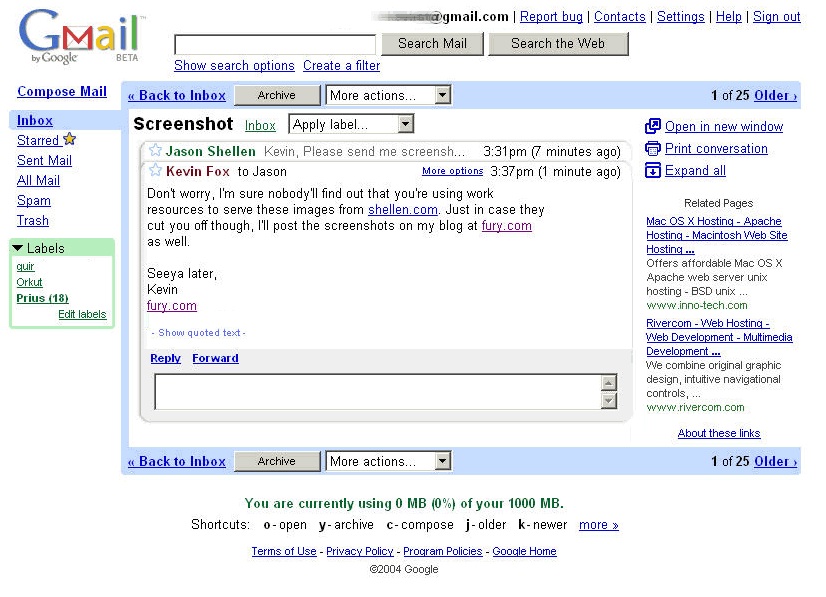
Thinking of Gmail as an app rather than a site had technical implications, too. Hotmail and Yahoo Mail had originally been devised in the mid-1990s; they sported dog-slow interfaces written in plain HTML. Almost every action you took required the service to reload the entire web page, resulting in an experience that had none of the snappy responsiveness of a Windows or Mac program.
With Gmail, Buchheit worked around HTML’s limitations by using highly interactive JavaScript code. That made it feel more like software than a sequence of web pages. Before long, the approach would get the moniker AJAX, which stood for Asynchronous JavaScript and XML; today, it’s how all web apps are built. But when Gmail was pioneering the technique, it wasn’t clear that it was going to work.
The ambitious use of JavaScript “was another thing most people thought was a pretty bad idea,” Buchheit says. “One of the problems we had was that the web browsers weren’t very good back then…We were afraid we’d crash browsers and nobody would want to use it.”
The more JavaScript that Gmail used, the more sophisticated it could get. One of its flagship features ended up being that the messages in your inbox weren’t strictly sequential. Instead, with the aim of making it easier to follow discussion threads, all the messages in a given back-and-forth string were collected into a cluster called a conversation, with any duplicated text automatically concealed. From a design perspective, says Fox, “trying to make it so that conversations were obvious to the user and intuitive was the largest challenge.”
"We weren’t going to plaster it with banners. We committed to that from pretty early on."
Then there was Gmail’s business model. Some within Google advocated for it being a paid service, but Buchheit and others wanted the service to reach as many people as possible, which was an argument for it being free and supported by advertising. With other free email offerings of the time, that meant flashy graphical banner ads–the antithesis of the unobtrusive little text ads which, then as now, accompanied Google search results.
“We weren’t going to plaster [Gmail] with banners,” says Rakowski. “We committed to that from pretty early on.” Instead, Gmail got little text ads of its own, automatically keyed to words in the text of a user’s email. In an example Google used early on to explain the system, two ads for ticket agencies were displayed alongside a conversation that mentioned a Beach Boys concert.
As with other aspects of Gmail, it wasn’t a given that the plan to monetize it through text ads would work. “I remember trying to model out how valuable each user would be in terms of advertising,” remembers Rakowski. “We had no idea.”
Advertising wasn’t just a math problem. Other email services already scanned the text of incoming messages, to check for spam and viruses, for instance. But doing the same thing for advertising purposes was something new, and Google knew that some people might be creeped out by any tangible evidence that their messages had been read, even if the one doing the reading was a machine.
“We thought pretty hard before doing what we did,” says Harik. “We thought, is this thing a perceived privacy violation or a real one? We decided it would be an issue of perception.”
Going Public
For much of its development, Gmail had been a skunkworks project, kept secret even from most people within Google. “It wasn’t even guaranteed to launch–we said that it has to reach a bar before it’s something we want to get out there,” says Fox.
By early 2004, however, Gmail worked, and almost everybody was using it to access the company’s internal email system. It was time to settle on a schedule for a public announcement. The date the company selected was April 1.
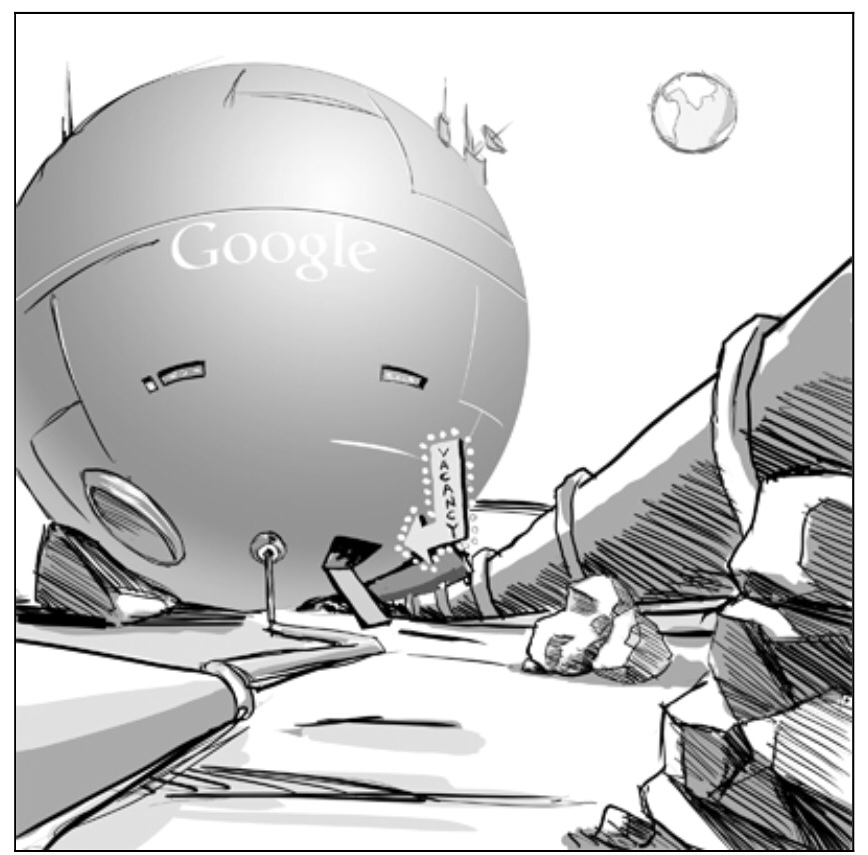
That wasn’t just another random day on the calendar. Google had begun its tradition of April Fools’ mischief in 2000; the company had a hoax in the works for 2004, involving an announcement that it was hiring for a new research center on the moon. It figured, correctly, that announcing Gmail at the same time would lead some people to think that the announcement was a prank. Especially since the 1GB of space was unimaginably ginormous by 2004 standards.
“Sergey was most excited about it,” says Rakowski. “The ultimate April Fools’ joke was to launch something kind of crazy on April 1st and have it still exist on April 2nd.”
“If you're far enough ahead that people can't figure out if you're joking, you know you've innovated."
The team had to scamper to make the deadline, and in fact, Gmail wasn’t really ready to go: Google didn’t have the awesome server capacity in place to give millions of people reliable email and a gigabyte of space apiece. “We had a Catch-22 when we launched,” Buchheit remembers. “We couldn’t get many machines because people thought we couldn’t launch, but we couldn’t launch because we didn’t have machines.”
In the end, Gmail ended up running on three hundred old Pentium III computers nobody else at Google wanted. That was sufficient for the limited beta rollout the company planned, which involved giving accounts to a thousand outsiders, allowing them to invite a couple of friends apiece, and growing slowly from there.
As news about Gmail dribbled out on March 31 and continued into April Fools’ Day, the reaction did, indeed, include a fair amount of disbelief. “If you’re far enough ahead that people can’t figure out if you’re joking, you know you’ve innovated,” says Harik. “Primarily, journalists would call us and say ‘We need to know if you’re just kidding, or if this is real.’ That was fun.”
Once it was clear that Gmail was the real deal, the invitations became a hot property. The limited rollout had been born of necessity, but “it had a side effect,” says Harik. “Everyone wanted it even more. It was hailed as one of the best marketing decisions in tech history, but it was a little bit unintentional.”
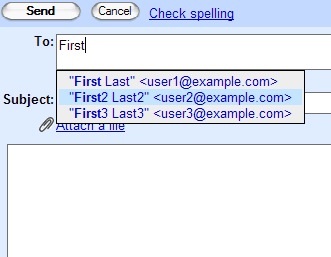
Bidding for invites on eBay sent prices shooting up to $150 and beyond; sites such as Gmail Swap emerged to match up those with invites with those who desperately wanted them. Having a Hotmail or Yahoo Mail email address was slightly embarrassing; having a Gmail one meant that you were part of a club most people couldn’t get into.
Despite the publicity windfall, Buchheit sounds a tad wistful about the situation, even a decade later: “I think Gmail could have grown a lot more in the first year if we’d had more resources.”
The aura of exclusivity and experimentation stuck to Gmail long after it did grow huge. Google kept increasing the number of invites each user could issue, but it didn’t open up the service to all comers until Valentine’s Day, 2007. And Gmail wore its Beta label like a badge of honor until July of 2009. (The company finally removed it as a sop to cautious business customers, who didn’t want to sign up for something that sounded unfinished.)
Gmail’s use of advertising keyed to the contents of email messages raised hackles–maybe more so than Google had anticipated. Some critics thought it invaded the privacy of the sender; others felt that the recipient was the party whose rights had been violated. Fear of inappropriate placements—such as pharmaceutical ads next to an email concerning suicide—was a common theme. And some people had reasonable questions about what Google would do with the data it collected to serve the ads, and how long it would preserve it.
Gmail’s limited release—the same thing that had some people giddily competing for invites on eBay—left others developing an antipathy to the service based on assumptions rather than reality. “I went to dinner parties at friends of friends,” says Rakowski. “People would talk about Gmail, not knowing that I worked on it, understanding it incorrectly because they hadn’t had a chance to try it.”
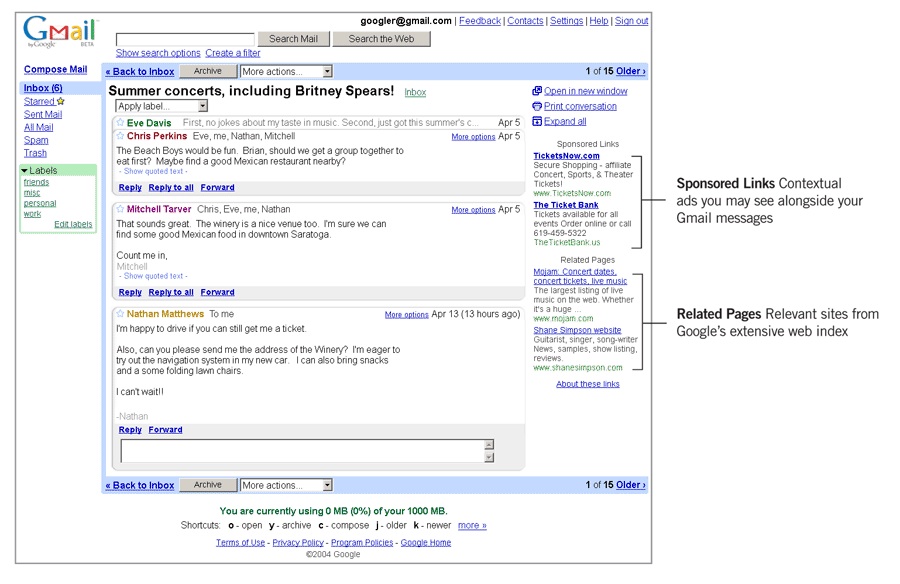
The reaction from privacy groups got ugly fast. On April 6, 31 organizations and advocates co-signed a letter to Page and Brin, raising a gaggle of concerns about Gmail, calling it a bad precedent and asking that the service be suspended until their concerns could be addressed. “Scanning personal communications in the way Google is proposing is letting the proverbial genie out of the bottle,” they warned.
Right in Google’s own backyard, California State Senator Liz Figueroa (D-Fremont) sent Google a letter of her own, calling Gmail a “disaster of enormous proportions, for yourself, and for all of your customers.” She went on to draft a bill requiring, among other things, that any company that wanted to scan an email message for advertising purposes get the consent of the person who sent it. (By the time the California Senate passed the law, cooler heads prevailed and that obligation had been eliminated.)
Google reacted to the controversy over Gmail’s ads by listening to the critics, detailing its policies on the Gmail site and spotlighting the work of journalists who thought the controversy was silly. It didn’t cave to those who demanded fundamental change to the service, and pushed back at what it argued was irresponsible behavior by some of the service’s foes:
When we began the limited test of Gmail, we expected our service would be the subject of intense interest. What we did not anticipate was the reaction from some privacy activists, editorial writers and legislators, many of whom condemned Gmail without first seeing it for themselves. We were surprised to find that some of these activists and organizations refused to even talk to us, or to try first-hand the very service they were criticizing. As we read news stories about Gmail, we have regularly noticed factual errors and out-of-context quotations. Misinformation about Gmail has spread across the web.
That’s unfortunate for Google, but why should you care? Because it may affect your right to make your own decisions about how you read your mail. This misinformation threatens to eliminate legitimate and useful consumer choices by means of legislation aimed at innocuous and privacy-aware aspects of our service, while simultaneously deflecting attention from the real privacy issues inherent to all email systems.
“Ten years from now, we’ll probably look back at the Gmail dust-up with…befuddlement,” wrote Slate’s Paul Boutin, one of the journalists whose pro-Gmail stances Google linked to in its response to the privacy flap. Mostly, we do: In 2012, the last time Google issued an official count, Gmail had 425 million active users, which suggests that discomfort with its approach to advertising is a minority view. The issue has never vanished entirely, though. It’s still in the courts, and Microsoft continues to tell consumers that it’s a reason to use Outlook.com, Hotmail’s successor.
A Decade Later
One remarkable thing about Gmail that wasn’t obvious in 2004: Its creators built it to last. The current incarnations of Outlook.com and Yahoo Mail have nothing to do with the email services Microsoft and Yahoo offered 10 years ago. But Gmail–despite having added features more or less continuously and gone through some significant redesigns–is still Gmail.
“I can’t think of another app that has existed so close to its original form for 10 years,” says Fox. “Someone who had only used Gmail in its first iteration and suddenly used it today would still understand Gmail. They’d know how to use it for virtually everything they’d want to do.”
“What makes the product what it is really comes from the continuous focus on the types of problems we’re trying to solve for our users,” says Alex Gawley, Gmail’s current product manager. “If you look back to 2004, the big problems email users were facing were having to delete messages for lack of storage, not being able to find messages and crazy amounts of spam.” Today, the big opportunities include making Gmail more action-oriented–which Google is doing with features such as live flight status information displayed within messages–and reimagining it for mobile devices such as phones and tablets. Gawley says challenges like those are enough to keep the Gmail team busy for the next half-decade.
Of course, no matter how inventive Gmail remains, it’s now the establishment. When newfangled apps and services such as Mailbox and Alto come along, the experience they’re reimagining is one created by Gmail, more than any other single email client, over the last decade. The creators of any new service would be thrilled to do to Google what Google did to Microsoft and Yahoo in 2004.

Then again, some of the issues email still has may not lend themselves to the sort of problem-solving Silicon Valley knows how to tackle. When I dropped Buchheit a line at his Gmail address asking to chat with him for this story, I got an automated message explaining that he was on hiatus from email—checking in, but only sporadically. Did Gmail’s creator think that email was broken all over again?
”The problem with email now is that the social conventions have gotten very bad,” Buchheit told me once we’d made contact. “There’s a 24/7 culture, where people expect a response. It doesn’t matter that it’s Saturday at 2 a.m.–people think you’re responding to email. People are no longer going on vacation. People have become slaves to email.”
“It’s not a technical problem. It can’t be solved with a computer algorithm. It’s more of a social problem.”
Sounds like the man who fixed email in 2004 is saying that the only folks who can fix it in 2014 and beyond are those of us who use it–and sometimes abuse it–it every day.
More Must-Reads from TIME
- Why Biden Dropped Out
- Ukraine’s Plan to Survive Trump
- The Rise of a New Kind of Parenting Guru
- The Chaos and Commotion of the RNC in Photos
- Why We All Have a Stake in Twisters’ Success
- 8 Eating Habits That Actually Improve Your Sleep
- Welcome to the Noah Lyles Olympics
- Get Our Paris Olympics Newsletter in Your Inbox
Contact us at letters@time.com